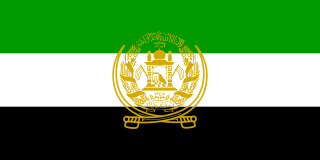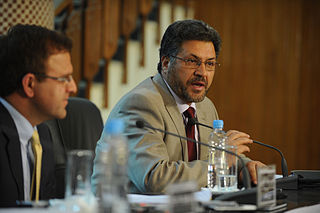
Burhānuddīn Rabbānī was an Afghan politician and teacher who served as President of Afghanistan from 1992 to 1996, and again from November to December 2001.

The government of Afghanistan is currently disputed following the effective collapse of the Islamic Republic of Afghanistan during the fall of Kabul to Taliban forces on 15 August 2021 and the subsequent re-establishment of the Islamic Emirate of Afghanistan which now exercises de facto control over most of the country. On 7 September 2021 the Taliban officials in de facto control of most of Afghanistan announced a new interim government headed by Mullah Mohammad Hassan Akhund as Prime Minister. The government is subject to the oversight of the Taliban's Supreme Leader, Haibatullah Akhundzada. As of 8 September 2021, the Islamic Emirate of Afghanistan has not yet been formally recognized as the de jure government of Afghanistan by any other country. The representatives appointed by the Islamic Republic of Afghanistan continue to represent the country at the United Nations. These representatives have refused to recognize the Taliban appointed government and have urged other countries to not recognize this government either.

Gulbuddin Hekmatyar is an Afghan politician, former mujahideen leader and drug trafficker. He is the founder and current leader of the Hezb-e-Islami Gulbuddin political party, so called after Mohammad Yunus Khalis split from Hezbi Islami in 1979 to found Hezb-i Islami Khalis. He has twice served as Prime Minister during the 1990s.
The following lists events that happened during 1996 in Afghanistan.

This article on the history of Afghanistan covers the period from the fall of the Najibullah government in 1992 to the end of the international military presence in Afghanistan.

The Islamic State of Afghanistan was the government of Afghanistan that was established by the Peshawar Accords of 26 April 1992 by many, but not all, Afghan mujahideen parties, after the fall of the socialist government. Its power was limited due to the country's second civil war, which was won by the Taliban, who took control of Kabul in 1996. The Islamic State then transitioned to a government in exile and led the anti-Taliban Northern Alliance. It remained the internationally recognized government of Afghanistan at the United Nations until 2001, when the Transitional Islamic State of Afghanistan was created and an Afghan Interim Administration took control of Afghanistan with US and NATO assistance following the overthrow of the first Taliban government.

Abdulrab Rasul Sayyaf is an exiled Afghan politician and former mujahideen commander. He took part in the war against the Marxist–Leninist People's Democratic Party of Afghanistan (PDPA) government in the 1980s, leading the Afghan mujahideen faction Ittehad-al-Islami.
A jirga is an assembly of leaders that makes decisions by consensus according to Pashtunwali, the Pashtun social code. It is conducted in order to settle disputes among the Pashtuns, but also by members of other ethnic groups who are influenced by them in present-day Afghanistan and Pakistan.

Jamayat-E-Islami, sometimes shortened to Jamiat, is a predominantly Tajik political party in Afghanistan. It was originally formed as a student political society at Kabul University. It has a communitarian ideology based on Islamic law. During the Soviet–Afghan War and the following Afghan Civil War against the communist government, Jamiat-e Islami was one of the most powerful of the Afghan mujahideen groups. Burhanuddin Rabbani led the party from 1968 to 2011, and served as President of the Islamic State of Afghanistan from 1992 to 2001, in exile from 1996.

Sibghatullah Mojaddedi was an Afghan politician, who served as Acting President after the fall of Mohammad Najibullah's government in April 1992. He was the first leader to call for armed resistance against the Soviet-backed regime in 1979 and founded the Afghan National Liberation Front at the time; later becoming a respected figure among the various Afghan mujahideen. He served as the chairman of the 2003 loya jirga that approved Afghanistan's new constitution. In 2005, he was appointed chairman of the Meshrano Jirga, upper house of the National Assembly of Afghanistan, and was reappointed as a member in 2011. He also served on the Afghan High Peace Council. Mojaddedi is considered to have been a moderate Muslim leader.

Mohammad Nabi Mohammadi was an Afghan politician and mujahideen leader who was the founder and leader of the Harakat-i-Inqilab-i-Islami political party and paramilitary group. He served as President of Afghanistan under the mujahideen from January 1993 to 1996.
The following lists events that happened during 1994 in Afghanistan.
The following lists events that happened during 1995 in Afghanistan.

The Afghan Interim Administration (AIA), also known as the Afghan Interim Authority, was the first administration of Afghanistan after the fall of the Taliban regime and was the highest authority of the country from 22 December 2001 until 13 July 2002.

Abdullah Abdullah is an Afghan politician who led the High Council for National Reconciliation (HCNR) from May 2020 until August 2021, when the Afghan government was overthrown by the Taliban. The council had been established to facilitate peace talks between the Islamic Republic of Afghanistan and the Taliban insurgents. Abdullah served as the Chief Executive of Afghanistan from September 2014 to March 2020, and as Minister of Foreign Affairs from December 2001 to April 2005. Prior to that, he was a senior member of the Northern Alliance, working as an adviser to Ahmad Shah Massoud. He worked as an ophthalmologist and medical doctor in the 1980s.

Ghulam Farooq Wardak is a politician in Afghanistan, formerly serving as the Minister of Education. He was appointed to that position by Afghan President Hamid Karzai on October 11, 2008.
Habib Mangal is an Afghan citizen who was a candidate in Afghanistan's 2009 Presidential elections.

An emergency loya jirga was held in Kabul, Afghanistan between 11 and 19 June 2002 to elect a transitional administration. The loya jirga was called for by the Bonn Agreement and Bush administration. The agreement was drawn up in December 2001 in Germany. Conducted under United Nations auspices, the talks at Bonn sought a solution to the problem of government in Afghanistan after the US ousted the Taliban government.
Mohammad Nasim Faqiri is an Afghan politician and diplomat. He has served as a longtime spokesman for Jamiat-e Islami in Afghanistan, and was appointed Secretary General of the organization.
The Ahmadzai is a Pashtun subtribe of the Ghilji confederacy. Ahmadzai Pashtun tribe is a Powandah tribe and are traditional nomadic merchant warriors. They are considered as the pioneers of trade among other Powandah merchant tribes. The tribe is more prosperous and are greeted with respect. Ahmadzai tribe is the largest tribe among Pashtuns. They follow Pashtunwali rigidly and are known for their Jirgahs. In history Ahmadzai are one of the strongest tribes and had control of power in Afghanistan. Ahmadzai tribe is known for their hospitality and strict code of conduct. There are some rules which no one can break and if they took responsibility they mean it. Currently, they are living in Afghanistan and Pakistan. They have properties in Islamabad and Peshawar. Large number of Ahmadzai have fought against the US invasion of Afghanistan. Traditionally, the Ahmadzai ranged from Logar to Jalalabad, but mostly in Paktia, Paktika, and Khost. A large portion of the tribe live as Kochi nomads. Sub Tribes of Ghilzai Ahmadzai are Isa Khel, Jabar Khel, Maruf Khel, Musa Khel, Zandak Khel, Ya Khel. There are some other tribes within these sub-tribes. The former Afghan presidents Ashraf Ghani Ahmadzai (2014–2021) and Mohammad Najibullah Ahmadzai (1987–1992) belonged to the Ahmadzai tribe.












